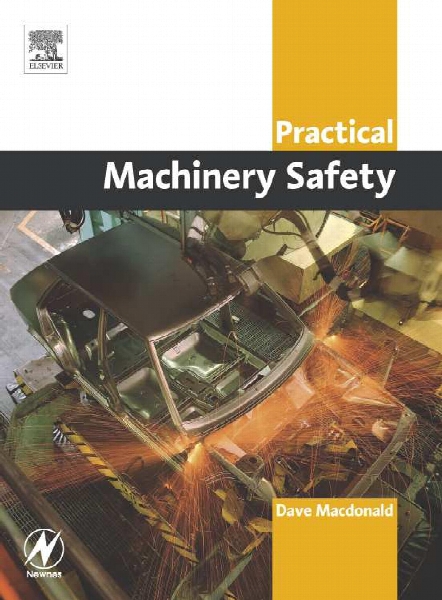Practical machinery safety
- نوع فایل : کتاب
- زبان : انگلیسی
- مؤلف : D MacDonald
- ناشر : Oxford : Newnes
- چاپ و سال / کشور: 2004
- شابک / ISBN : 9780750662703
Description
1 Introduction to the machinery safety workshop .................................................... 1 1.1 Scope and objectives ........................................................................... ...2 1.2 Machinery and controls ........................................................................ ...2 1.3 Distinction between machinery and process safety control systems..... ...7 1.4 International standards and practices ................................................... ...8 1.5 Introduction to hazards and risks.......................................................... .10 1.6 Risk reduction....................................................................................... .11 1.7 The Alarp principle for tolerable risk ..................................................... .12 1.8 Development example for a machinery safety system.......................... .14 1.9 The engineering tasks .......................................................................... .19 1.10 Benefits of the systematic approach ..................................................... .22 1.11 Conclusions.......................................................................................... .23 2 Guide to regulations and standards ................................................................... 24 2.1 Purpose and objectives ........................................................................ .24 2.2 History and overview of European Directives and Standards ............... .25 2.3 The European Machinery Directive....................................................... .33 2.4 Conformity procedures ......................................................................... .39 2.5 Other ‘New Approach Directives’ .......................................................... .44 2.6 User side directives: workplace health and safety legislation ............... .46 2.7 Some machinery safety standards........................................................ .49 2.8 Regulations and standards in the USA................................................. .52 2.9 Conclusions.......................................................................................... .55 References ........................................................................................... .55 3 Risk assessment and risk reduction ................................................................... 56 3.1 Purpose and objectives ........................................................................ .56 3.2 Introduction to risk assessment ............................................................ .56 3.3 Procedure for risk assessment ............................................................. .57 3.4 Hazard study methods.......................................................................... .66 3.5 Risk estimation ..................................................................................... .71 3.6 Risk reduction principles....................................................................... .79 3.7 Outcomes of the risk assessment......................................................... .85 3.8 Documentation methods for the risk assessment ................................. .90 3.9 Conclusions.......................................................................................... .91 References ........................................................................................... .91 vi Contents 4 Design procedures for safety controls................................................................ 92 4.1 Introduction to design techniques ......................................................... 92 4.2 Review of design standard EN 954-1.................................................... 93 4.3 Procedure for the design of safety controls based on EN 954 .............. 94 4.4 Design considerations...........................................................................97 4.5 Safety categories ................................................................................ 104 4.6 Conclusions ........................................................................................ 110 References ......................................................................................... 111 5 Emergency-stop monitoring and the safety relay ............................................. 112 5.1 Introduction......................................................................................... 112 5.2 Definitions and implications of stop functions...................................... 112 5.3 Safety relay terminology ..................................................................... 114 5.4 How does an E-stop safety relay work? .............................................. 116 5.5 Practical safety relays ......................................................................... 117 5.6 Certification......................................................................................... 125 5.7 Functional overview of monitoring relays ............................................ 125 5.8 Electronic and programmable E-stop monitors ................................... 127 5.9 Using monitoring safety relays for guards (safety gate monitors)........ 128 5.10 Review of other monitoring relay functions ......................................... 128 5.11 Conclusions ........................................................................................ 130 References ......................................................................................... 131 6 Sensors and devices for machinery protection ............................................... 132 6.1 Contents summary.............................................................................. 132 6.2 Purpose and objectives....................................................................... 132 6.3 Review of guards ................................................................................ 138 6.4 Sensing devices for guards................................................................. 144 6.5 Mechanical trapped key interlocking ................................................... 152 6.6 Presence sensing devices .................................................................. 154 6.7 Control devices for safety.................................................................... 163 6.8 Safety networks and sensors .............................................................. 166 6.9 Conclusions ........................................................................................ 168 7 Application guidelines for protection devices ................................................... 169 7.1 Introduction......................................................................................... 169 7.2 Choosing protection methods ............................................................. 170 7.3 Guarding devices ................................................................................ 171 7.4 Point of operation devices................................................................... 173 7.5 Application guidance notes for light curtains ....................................... 180 7.6 Conclusions ........................................................................................ 188 8 Programmable systems for safety controls ...................................................... 190 8.1 Introduction......................................................................................... 190 8.2 Benefits and disadvantages of safety PLCs........................................ 195 8.3 Characteristics of safety PLCs............................................................ 201 8.4 Application software............................................................................ 214 Contents vii 8.5 Safe networking....................................................................................215 8.6 Classification and certification of safety PLCs ......................................218 8.7 Summary..............................................................................................219 References...........................................................................................219 9 Introduction to standards for programmable systems ........................................220 9.1 Introduction...........................................................................................220 9.2 Objectives.............................................................................................220 9.3 Outline of IEC 61508 ............................................................................221 9.4 Concept of SILs....................................................................................226 9.5 How can we determine the required SIL for a safety function?.............228 9.6 Some implications of IEC 61508 for machinery systems ......................230 9.7 Summary..............................................................................................232 9.8 Conclusion............................................................................................232 References...........................................................................................233 Appendix: Notes on the method for the determination of SILs for a machinery safety application........................................................234 Appendix A: References and sources of information on machinery safety ...................240 Appendix B: Glossary ...................................................................................................243 Appendix C: Notes on tolerable risk..............................................................................248 Appendix D: Notes on PUWER ....................................................................................252 Appendix E: Guide to fault tree analysis .......................................................................257
Practical Machinery Safety aims to provide you with the knowledge to tackle machinery safety control problems at a practical level whilst achieving compliance with national and international standards. The book highlights the major international standards that are used to support compliance with EU regulations and uses these standards as a basis for the design procedures. It looks at the risk assessment processes used to identify hazards and to quantify the risks inherent in a machine. It introduces the concepts of safety categories as defined by standard EN954-1 (Safety of Machinery) and illustrates the principles of failsafe design, fault tolerance and self-testing. It also provides an introduction to machinery protection devices such as guards, enclosures with interlocks and guard-monitoring relays, locking systems, safety mats, photo-electric and electro-sensitive principles and the application of light curtains, a study of Safety Control System techniques, and introduces the principles of safety-certified PLCs. 1. Plan and implement safety systems that deliver a safe working environment and compliance with national and international standards. 2. Apply simple risk assessments and hazard design methods to your own projects 3. Identify hazards that occur with machinery and know how to deal with them.


